DO-IT News April 2022

Volume 30, Number 2
Below are the articles from the DO-IT News April 2022 newsletter. These articles can also be seen all on one page at the Full Newsletter option.
Celebration of Life of the First DO-IT Scholar: Rodney Lewis (7/4/1975 - 11/4/2021)
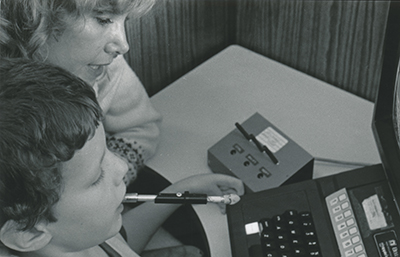
Sheryl Burgstahler, DO-IT Director
I am sad to report the passing of Rodney Lewis. I met him when he was six years old, and he became my inspiration for the design of the DO-IT Scholars program. In 1992 I submitted a grant proposal to the National Science Foundation (NSF) to fund a program for teens with disabilities; however, before approving the grant, the NSF required that I provide a proof of concept regarding the ability of a teen with a disability to get connected and engage with mentors and staff online at a time when the internet was only readily available to universities, research organizations, and large companies. I chose Rodney to be the test case, and he became the first Scholar and the only one who was selected before we instituted a formal application process. The test was successful and the rest is history; we have continued to fund the DO-IT Scholars program ever since, first with NSF funds and later with Washington State and other corporate and individual contributions. Rodney also introduced me to the field of assistive technology (AT), as described in the following excerpt from my book Creating Inclusive Learning Opportunities in Higher Education: A Universal Design Toolkit (2020, Harvard Education Press, p. 75–77):
In 1982, I learned about a local six-year-old, Rodney, unable to use his hands because of a condition called arthrogryposis, who was learning to type on an electric typewriter using a stick in his mouth, called a mouth wand. I met his special education teacher who wondered if Rodney could operate a computer. I didn’t know for sure but invited her, Rodney, and his family to come to our Microcomputer Resource Center at Saint Martin’s College, where I taught mathematics, computer science, and education courses. Before I met him, his teacher shared with me a copy of the first letter Rodney wrote on a typewriter. In part, he said:
May 3. 1982,
Dear President Reagan,
I want to tell you my name. My name is Rodney and I Am 6 years old . . . I am handicapped bebecause I can’t use my legs or my hands because I have little muscles and dbones.
I go to Skyline Exceptional School . . . I get to learn to type with my special mouth wand. Someday I will get to use a computer because I am smart even tho handicapped.
This is my first letter L typed. I Worked hard typing. TThank you for being nice .
Rodney
Who wouldn’t want to get to know this kid? In our first meeting, we quickly realized that Rodney could perform all of the functions available through an Apple II computer keyboard using his mouth wand except for those requiring him to press two keys simultaneously. The inability of the Shift, Control, and Repeat keys to be locked presented a barrier to him. So, I embarked on a journey to find a way to fix this computer limitation. First, contacting Apple Inc. and then passing through a chain of technology leaders with no luck, I finally found Gregg Vanderheiden and his colleagues at the Trace Center at the University of Wisconsin. One phone conversation led to the delivery in postal mail of a hand-drawn diagram showing how to build a switch box to lock the Shift, Control, and Repeat keys. I hired an engineering student at the college to build it. Included is an image of me with Rodney as he controls a computer using his mouth wand, computer keyboard, and “magic” switch box.
This was my first experience in a field of research and practice—assistive technology—that was opening a world of digital opportunities for individuals with disabilities. I met with Rodney once a week for many years to teach him word processing, other applications, and programming. By the time he was eight years old, Rodney was sharing programming tips with my college students.
Word about Rodney spread. St. Martin’s became a magnet for people exploring computer access issues for individuals with disabilities. I recruited as many experts as I could find to teach Saturday workshops on computer use by people with physical disabilities and, later, sensory differences and, later still, learning disabilities.
Because of these experiences, when I was hired to lead the new Microcomputer Support Group (MSG) at the University of Washington in 1984, I immediately added making IT accessible to faculty, students, and staff with disabilities to the MSG mission statement. In those days, Rodney and I could not have imagined that by today there would be thousands of commercially available AT products, let alone the many features that benefit individuals with disabilities that are integrated into mainstream IT. The locking functions we achieved with Rodney’s switch box are now routinely built into operating systems as “sticky keys.”
Neuroscience for Neurodiverse Learners Accepting Applicants
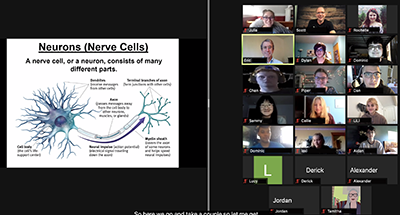
During the past two summers, Dr. Eric Chudler has led the neuroscience discussions during the Neuroscience for Neurodiverse Learners (NNL) program. As a research associate professor and executive director of the Center for Neurotechnology at the University of Washington, Eric has offered engaging lectures on everything from neuroscience in media to music. For those who can’t get to his labs or lectures, Eric and UWTV have created the BrainWorks series where he and a group of high school students explore topics like “Sleep and the Brain,” “Exercise and the Brain,” “Brain-Computer Interface,” and “Kids and Sports-Related Injuries.” Every video is accompanied by a user’s guide, making it easy to watch alone or use as an educational tool in a classroom. These videos can be found on the UW Video website.
Over the past two years, NNL has brought together over 50 neurodiverse high school students to learn about neuroscience as well as gain valuable life skills and peer connections to prepare for their transition to college.
If you or someone you know is a neurodiverse high school junior or senior interested in STEM, the application to participate in NNL can be found online. This year’s summer program runs from August 8-19, 2022, and is currently accepting applicants.
AccessComputing PI Elected AAAS Fellow
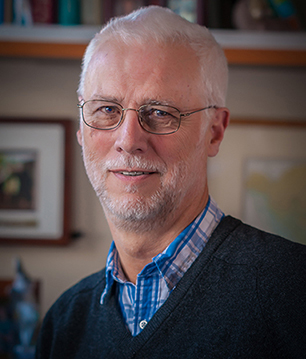
We are excited to celebrate AccessComputing PI, Richard Ladner, who was elected a 2021 Fellow of the American Association for the Advancement of Science (AAAS). The AAAS elects Fellows based on their standout work in the scientific community. Richard, University of Washington Allen School professor emeritus, was nominated for his decades of advocacy to make computing more accessible and inclusive for people with disabilities. This lifelong honor rewards Richard's ongoing advocacy and leadership above and beyond the norm in a field that has historically been underserved.
AccessComputing is honored to be led by Richard and partner with him on several other projects. We look forward to seeing the continued legacy of Richard's leadership in making computing and technology more accessible to individuals with disabilities.
To learn more about Richard Ladner's accomplishments, see the article by Allen School News.
2021 AccessComputing Capacity Building Awards
We are pleased to announce that the 2021 AccessComputing Capacity Building Awards go to longtime friend of AccessComputing Rob Parke and AccessComputing partner Patricia Ordoñez for their work advancing the inclusion of disability and accessibility in the Tapia Celebration of Diversity in Computing.
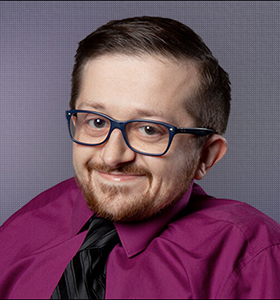
Rob Parke is an associate professor of information technology practice in the Information Technology Program in the Viterbi School of Engineering at the University of Southern California (USC). He has a strong interest in inclusive teaching practices and has been actively involved in addressing issues of inclusion and equity, both within USC and externally. He served as general chair of the 2021 CMD-IT/ACM Richard Tapia Celebration of Diversity in Computing Conference which encourages and supports diversity within computing. Outside of academia, Rob has a lifelong love of technology from the technical to the creative, with professional experience in software development, information technology, web design, audio engineering, film and TV post-production, and digital media.
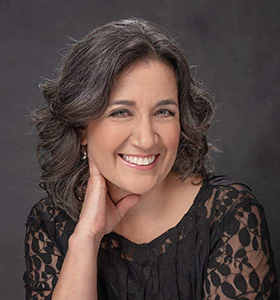
Patricia Ordóñez was the first Latina to graduate with a Ph.D. from the College of Engineering and Information Technology at the University of Maryland Baltimore County and the first female associate professor to earn tenure in the Computer Science Department at the University of Puerto Rico Río Piedras (UPRRP). She is a former National Science Foundation Graduate Research Fellow. She is serving as general chair at the 2022 Tapia Celebration of Diversity in Computing Conference as well as co-chair of the Diversity and Inclusion Council of the Association of Computing Machinery (ACM). She is the recipient of the Great Minds in STEM 2021 HENAAC Award in Education. She is passionate about creating a more inclusive culture in computing and STEM and about bridging the digital and data divide in global healthcare and education.
New Book Focused on Computer Science and Diversity
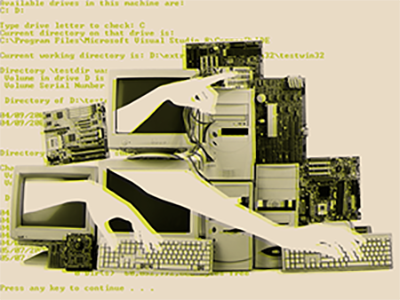
My collaborators and I published a new book in December titled Critically Conscious Computing: Methods for Secondary Education. The book covers the entire scope of computer science (CS) concepts from a social justice perspective, connecting technical ideas in CS to disability, gender, and racial justice. It also provides a survey of CS teaching methods and offers example unit plans for teaching CS in ways that develop students’ critical consciousness about CS. The book is available freely as an online, fully accessible website at criticallyconsciouscomputing.org. While it speaks directly to middle and high school teachers, the content is also relevant to faculty in higher education who are interested in teaching CS from a social justice perspective.
Ableism in Everyday Language
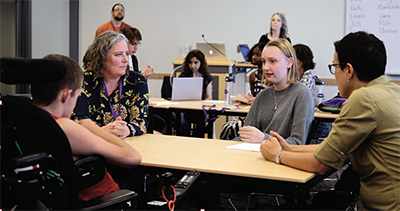
“Ableism” is a broad term that covers a lot of territory: It includes thinking about attitudes, behaviors, and interactions that negatively impact people with disabilities. Sometimes it’s unintentional and meant to be benign, although it comes across as patronising. Other times it’s more intentional and meant to send a message that some individuals with disabilities aren’t actually disabled and are somehow “cheating” or “playing the system.” Usually, if we have heard about ableism, it’s in regard to behavior and interactions. For example, we may have had a bit of training on how to interact with people with disabilities; how to not grab a blind person’s arm to guide them, or how to not take control of someone’s wheelchair without being asked for assistance. We may have been told to not ignore or gloss over the fact that a co-worker has a disability; that our discomfort is our issue, not theirs. We may have been told that ignoring their reality and barriers can create an unsafe environment for a disabled co-worker to speak up and ask for what they need in order to do their job. If nothing else, we’ve probably all been told in diversity training that paying attention to how we behave and act regarding disability are important aspects of inclusion.
However, few of us think about how often we use ableist language, constantly and unthinkingly. It has been normalized in everyday English in a wide variety of examples:
- “My life has just been crazy lately!”
- “I was late to work again because of traffic. Seattleites drive like lunatics!”
- “He can be a real moron, can’t he? That was a dumb thing to say.”
- “Who came up with that idiotic idea anyway? It’ll never work, it’s just lame.”
- “Remember that student who became hysterical when she learned she failed your last exam? Totally spazzed out? Well, I have that nutjob in my class this quarter.”
- “They are really obsessed with their grade; they’ve gone all OCD on it and are emailing me a dozen times a day. It’s starting to drive me mad.”
- “Teaching during the COVID pandemic has just been next-level insane. I went to that seminar on how to teach online but the trainer was a total, disorganized nutter; it was like the blind leading the blind.”
While it may be surprising to realize just how often we use ableist language, with just a little conscious effort, we can move our vocabulary and word choices towards a more thoughtful, effective usage.
Learn more about ableist language:
- ACES-The Society for Editing: Ableism in Writing and Everyday Language
- The BBC: The Harmful Ableist Language You Unknowingly Use
- Harvard Business Review: Why You Need to Stop Using These Words and Phrases
Learn more about ableism in general:
- AccessLiving: Ableism 101
- The Bernard College Center for Research on Women: No Body Is Disposable
- Invisible Disabilities Association: Looks Can Be Deceiving
- National Public Radio: People With Invisible Disabilities Fight for Understanding
Promoting Accessible Informal STEM Learning
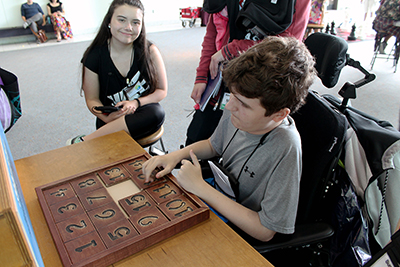
Learning about science, technology, engineering, and mathematics (STEM) can be a lot of fun, especially outside of traditional classroom settings at places like science centers, museums, summer camps, and visits to college campuses. These types of environments are often referred to as “informal STEM learning” (ISL) environments, and sometimes they are not accessible to individuals with disabilities.
On March 2-3, 2022, the NSF INCLUDES TAPDINTO-STEM Alliance partnered with Access to Informal STEM Learning (AccessISL) to host a national capacity building institute with over 70 stakeholders and representatives from ISL programs across the United States. Examples of participating institutions include the National Federation of the Blind; the Seattle Cultural Accessibility Consortium; the Riverside Art Museum; the UW Museology Program; the Pacific Science Center; the Museum of Science, Boston; the National Deaf Life Museum; the North Carolina Maritime Museum at Southport; and the Intrepid Sea, Air, and Space Museum.
The event included presentations from 24 speakers, who shared information and participated in lively discussions about improving access for everyone, with a variety of topics covered:
- Universal Design and Access to Informal Learning Environments
- Accessible Information Technology and Digital Engagement
- Pre-Engagement, Neurodiversity, and Social Narrative Development
- Direct Engagement of the Disability Community
- Exploring Free Resources and Building Stakeholder Networks
Consider joining this effort by exploring the AccessISL and TAPDINTO-STEM websites and/or joining the AccessISL Community of Practice. Proceedings from the capacity building institute will be published soon online and shared through the Community of Practice.
Thank You, DO-IT Advisory Board!
A special thanks to the DO-IT Advisory Board for all their work and support in choosing the newest Scholars every year. The Board is made up of professionals and parents who work diligently to provide us with the best matches for the program.
The Advisory Board also supports DO‑IT’s other programs by providing advice and knowledge. DO-IT appreciates their hard work and thoughtful input.
Making STEM Departments More Accessible to and Inclusive of Faculty with Disabilities
AccessADVANCE has released a publication titled Equal Access: Making STEM Departments More Accessible to and Inclusive of Faculty with Disabilities developed in collaboration with faculty with disabilities and equity experts. The publication offers strategies for systemic changes that will increase the successful participation and advancement of women with disabilities in STEM faculty careers.
Institutions are urged to consider:
- Does the department and campus ensure that new hires and other faculty are aware of the workplace accommodation process? Is the process clearly explained on faculty and public websites? Does this information include examples of accommodations provided? Does it encourage suggestions for making a department more inclusive?
- Is there a campus-supported organization that supports faculty with disabilities by facilitating communication, networking, support, and advocacy?
- Does the institution offer opportunities and strategies for faculty members to learn about and negotiate accommodations?
- Are there flexible policies that allow individuals to attend meetings and work remotely? Are important meetings captioned, recorded, and shared for those who cannot attend or wish to watch them at a later time?
- Is it made clear to faculty (perhaps in a faculty handbook or website) how they can request guidance in choosing assistive technology (perhaps through the central accessible IT unit)? Are central funds available for faculty members to procure assistive technology?
- Are accommodations approved and funded efficiently through a central institutional unit and budget so departments avoid the appearance that individual faculty members with disabilities are a financial burden? Are service units agile in their responses and do they consider requests that go beyond minimum compliance to consider funding for such things as teaching and research assistants, release time, summer months, and additional sabbatical credit for faculty with disabilities?
An Assistive Technology Program in Washington State Dedicated to Helping Individuals with Disabilities
Individuals with disabilities face challenges that limit their ability to live productive lives. From socializing and communicating with peers to typing on a computer or performing certain tasks for a job, they often don’t have the tools and resources that make it easier to succeed in less accessible settings.
That’s where the Washington Assistive Technology Act Program (WATAP) comes in. WATAP is a program that provides “services and resources to individuals with disabilities as well as older adults,” said Alan Knue, the program’s director. “Our mandate is statewide. We serve from birth through adulthood and aging.”
They conduct their services through the University of Washington campus where they prioritize technology in the fields of education, employment, and the community. WATAP operates under four core programs with regards to assistive technology.
“The first one is device demonstration, which allows people to have a tour of what AT is available for whatever their needs are with a professional guiding the way. And that’s intended to help people make informed decisions about which assistive technology (AT) work for them,” said Knue. This is similar to the device lending program, which allows clients to “borrow equipment for up to three weeks. And that allows them to try the assistive technology before they purchase it.” Both of these programs allows people to evaluate the effectiveness of a software application for their needs.
The other two programs that WATAP involve methods to acquire and access technology. “We have two major partners in state financing. We partner with the Northwest Access Fund to provide financing for assistive technology,” said Knue. “We also partner with the Perkins School for the Blind to run the National Deaf-Blind Equipment Distribution Program in Washington, which provides distance communication equipment, as well as training to individuals who have combined vision and hearing loss.”
WATAP offers a variety of assistive technology services that people can use for work, school, and other general life activities. They employ a number of AT specialists to work within the community. “The big part of what the AT specialists do for WATAP is we do a lot of professional training,” said Maria Kelley, WATAP’s senior assistive technology specialist. “And then we also do outreach presentations to various organizations who are requesting those types of presentations.”
WATAP’s AT specialists also work with people with disabilities on a one-on-one basis. They provide training on a variety of technology and confirm whether a person with a disability can access their technology and use it as intended. “We have them try their software in the various applications that they have to use the program, whether that’s a word document or navigate various web pages,” said Kelley. One example is when someone wants to use speech-to-text or speech-recognition software to control their computer or create documents or emails. “That’s how we gather information as to whether or not their voice is going to be compatible with the program and whether or not they have the cognitive abilities to be able to use it successfully and recall and learn the voice commands.”
AT specialists also do regular requests with school districts throughout the year to see what kind of software or devices students with disabilities need to make things more accessible. On top of that, they continue to review what types of technology are needed in the community so that WATAP can offer a wide variety of options.
Individuals with disabilities often don’t have the financial resources to purchase assistive technology equipment. WATAP steps in to cover those costs. “We try to purchase technology that the common person isn’t often able to afford so that they have an opportunity to try it out for the three-week period to help them make a more informed decision prior to making that financial investment on the technology,” said Kelley.
Knue hopes that individuals with disabilities can use assistive technology to their advantage in order to be successful not only in their academic careers, but also in their professional and personal lives as well.
“Giving people the tools that work for them is a really important piece of being able to participate in whatever they want to do. Whether that’s going into the grocery store, taking a class, or working their job.” said Knue. “We’re hoping that the ability to have demonstrations and lending, and maybe some alternative ways of getting the equipment, will help them get that equipment so that they’re able to succeed.”
Technology Assistance Offered by DO-IT
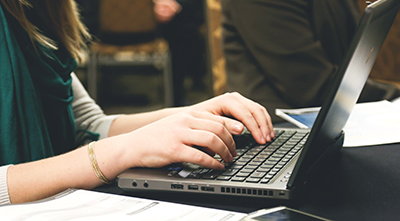
If you haven’t met me yet, I am the assistive technology specialist here at DO-IT, providing support for our participants on their various hardware and software needs. This often includes providing needed assistive technology, identifying and fixing problems that arise, and, one of my favorite parts of the job, providing all the equipment to our new Scholars each year!
For any issues with laptops, printers, or assistive technology on loan from DO-IT, Scholars should reach out immediately so I can identify the issue and check the warranty. For other participants, I always encourage an email. I am happy to help troubleshoot issues, discuss recommendations and point you toward appropriate resources. To reach me, email andrem25@uw.edu.
DO-IT Ambassadors Can Attend Conferences in 2022
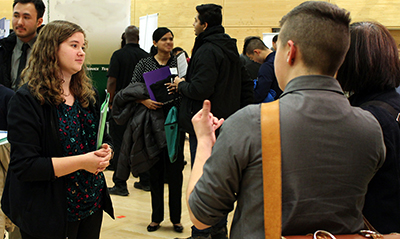
The DO-IT Scholars program offers many opportunities to network, meet mentors, and learn more about your field of study. DO‑IT is currently seeking requests to attend conferences from Ambassadors (Scholars who have graduated from high school) who are currently attending college. Please complete the form to be considered. You must currently be 18 years old or older to apply. Ambassadors have already attended or are planning on attending the SXSW EDU, 2022 Washington State Nonprofit Conference, CSUN Assistive Technology Conference (California State University at Northridge) and the #WhyNotMe STEM Conference.
Conference and workshop topics may include leadership, a specific field of study, presentation skills, and more. Some options and examples are listed below:
Past Examples
- The Technology Student Association annual conference
- CSUN Assistive Technology Conference (California State University at Northridge), Los Angeles, California
- SXSW EDU (hybrid): An annual event that fosters innovation and learning within the education industry
- The Forum on Workplace Inclusion annual conference
Upcoming Conferences
- The National Student Leadership Diversity Virtual Leadership Conference, April 30, 2022
- The 2022 Washington State Nonprofit Conference, May 18-20
- #Why Not Me STEM Conference, Lubbock, Texas: Featuring holistic, developmental response to promote diversity in STEM, May 22-25
Check on your local campus or in your community to find a variety of workshops on presentation skills or other topics that will help your education and career.
If you have specific questions, you can direct them to me at tamitha@uw.edu.
Scholar Profile: Teresa Buchholz
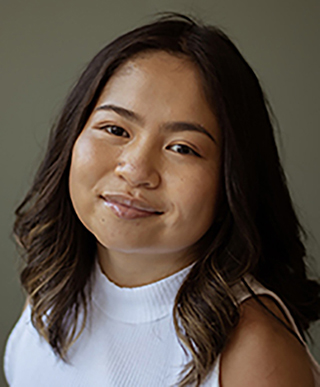
I am currently a senior at Seattle University finishing up my bachelor of science in psychology and am planning to attend Columbia University. Throughout my undergraduate studies, I developed a passion for working with underprivileged youth, which is why I am pursuing a master of social work. Outside of my academic commitments, I participate in many activities both on and off campus. I have served in many leadership positions; am a proud member of Seattle University Dance Team; and dedicate my time to serving the limb different community through mentorship, speaking, and coaching across America.
For the foreseeable future my goal is to work with underprivileged incarcerated youth, eventually working within policy change. I also would love to open a gym with adaptive workout gear. Holistically, my goals are rooted in empowering others and continuing my advocacy work for the disabled community.
Being a former DO-IT Scholar, I have come to appreciate the content of this program immensely. DO-IT prepared me to recognize what living in an able-bodied world looks like. They specifically taught us how to advocate, navigate, and be a change-maker in a greater effort to destigmatize the world around us. The most important thing I took away from the program that still resonates with me today is the strength I gained in embracing my identity as a disabled woman. DO-IT is a program that serves to empower each person to embrace the beauty within their own disabilities while also amplifying the need for voices like ours to create a more just and humane world.
2021 State of Computer Science Education
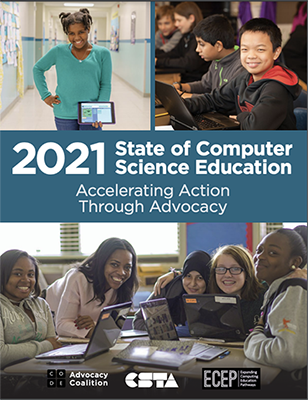
On November 3rd, Code.org, the Computer Science Teachers Association, and the Expanding Computing Education Pathways Alliance, released the 2021 State of Computer Science Education: Accelerating Action Through Advocacy. Published annually, the report provides the most comprehensive analysis of national progress in computer science education, featuring national and state-level policy and implementation data with a focus on equity and diversity.
Last year’s report had data on the participation of students served under the Individuals with Disabilities Education Act (IDEA) in computer science in 11 states. This year’s report has data on the participation of students served under both IDEA and Section 504 of the Rehabilitation Act in computer science in 19 states. Both of these categories are needed to count all K-12 students who have a disability and receive accommodations. In summary, students with 504 plans are slightly overrepresented in foundational high school computer science courses, but students with Individual Education Programs (IEPs) under IDEA are underrepresented. Data listed for each of the 19 states shows the percentage participation of students with disabilities in those states.
One table on page 107 shows the demographics of K-12 students in all 50 states in eleven categories including race/ethnicity categories, English language learners, economically disadvantaged, students with 504 plans, and students under IDEA. This remarkable table can be useful to all states in understanding their population of K-12 students. In total, 2.7% of K-12 students have 504 plans and 14% of students have IEPs.
Learn More about Creating Inclusive Learning Opportunities in Higher Ed
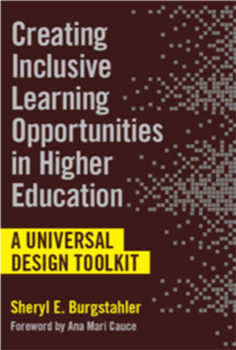
Published by Harvard Education Press, Sheryl Burgstahler’s newest book, Creating Inclusive Learning Opportunities in Higher Education, delivers a step-by-step guide for putting the principles of universal design (UD) into action for all aspects of a postsecondary campus. Sheryl offers top-down, bottom-up, and middle-out strategies for transforming a higher education environment into one where physical spaces, learning materials and activities, technology and digital resources, and campus services are welcoming and accessible to all students, while minimizing the need for accommodations for individuals with disabilities.
Complementing her edited book Universal Design in Higher Education: From Principles to Practice, this volume lays out how faculty, service providers, high level administrators, and other stakeholders can contribute to a barrier-free environment for all students, including those with disabilities. Along with principles, guidelines, practices, and processes that underpin a framework in which to conceptualize and apply UD, Dr. Burgstahler shares the implementation model to tailor to any campus exploring ways to meet broad goals with respect to diversity and inclusivity.
More details about the book can be found at Creating Inclusive Learning Opportunities in Higher Education: A Universal Design Toolkit and the book can be ordered online through Amazon or Harvard Education Press.
About DO-IT
DO-IT (Disabilities, Opportunities, Internetworking, and Technology) serves to increase the successful participation of individuals with disabilities in challenging academic programs and careers, such as those in science, engineering, mathematics, and technology. Primary funding for DO-IT is provided by the National Science Foundation, the State of Washington, and the U.S. Department of Education.
For further information, to be placed on the DO-IT mailing list, request this newsletter or other materials in an alternate format, or make comments or suggestions about DO-IT publications or web pages, contact us at
DO-IT
University of Washington
Box 354842
Seattle, WA 98195-4842
doit@uw.edu
www.uw.edu/doit/
206-685-DOIT (3648) (voice/TTY)
888-972-DOIT (3648) (toll free voice/TTY)
509-328-9331 (voice/TTY) Spokane
206-221-4171 (fax)
Founder and Director: Sheryl Burgstahler, Ph.D.
Program Manager: Scott Bellman
All in-person images in this publication are from pre-pandemic events.